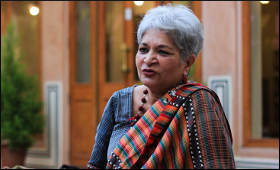|

|
'Millions of weavers vulnerable due to GST'
|
|

|
|
| Top Stories |
 |
|
|
|
Mudita Girotra | 09 Oct, 2017
Millions of India's poor artisans and craftspeople, struggling to keep alive their traditional crafts and livelihoods, have been hit hard by the introduction of the Goods and Services Tax (GST) that has pitted them in an unequal battle against machine-made products, says craft activist Laila Tyabji.
"The position of weavers is very vulnerable today because of GST. Handloom (products) were free of tax all these years, and it was very much part of national policy," Tyabji told agency in an interview.
Tyabji's organisation, Dastkar, works with craftspeople to promote and revive traditional crafts and recently organised "The Grand Saree Fair" featuring traditional sarees from across the country.
Stressing that most of them come from marginalised communities and need support, she said: "They received encouragement from successive governments. Mahatma Gandhi used to say that cottage industries and weavers' craft are part of India's culture, society and also economics."
"Now they are going to be taxed and there is uncertainty over the exact bracket. GST is a complex structure which is not looking at the material and the means with which it (a craft object) is made, whereas previously... if it was handloom and made by hand, there was no tax," Tyabji pointed out.
"Now, people are looking at it as a product. A machine-made garment would be competing with a handmade garment at the same rate, even though the machine-made thing has all the support of a company and advertising, while the small craftsman working in some village certainly doesn't have that kind of infrastructure.
"This is a very difficult time," she added.
Dastkar does thematic exhibitions every month. Next up is "Festival of Lights" -- a hand-crafted celebration of Diwali, which began on October 5 and will end on October 16.
Tyabji said India has many skills and not just crafts, but the country, rather than promoting these, is looking to replicate the industrial revolution of the West.
"Every region has its own unique style of doing something. This is something that no other country in the world has," she said.
"International designers, the export houses or buyers from brands are not coming to India because we are making Nikes... they are coming for the skills. They are coming because they have lost the craft in their country. We have with us hundreds of different skills but they don't," she added.
"The Chinese take our crafts people there to train their own own people. They realise we have something extraordinary here. We have the potential of adding value through their hand craft," she explained.
"They are skilled professionals. It is very complex to make those designs but we look at crafts people as somehow inferior to other skilled professionals," she lamented.
"There are weavers who are earning very well and most of them would still not want their children to be weavers because they are not accepted as skilled professionals," she added.
She said we are fortunate compared to many countries as we have a separate ministry for textiles, but the government works in a bureaucratic and complicated way.
"Though there are a lot of schemes for artisans, they are not easy to navigate. A lot more needs to be done. We need to invest in the crafts sector like we do in any other area of economic activity," said Tyabji.
Tyabji is known for her long and inspiring contribution to the crafts sector as co-founder, and now chairperson, of Dastkar, but said: "We are just a drop in the ocean. Dastkar works with around 100,000 people but there are around 15 million or so of them. We can only be a model of what can happen. If the government, designers, entrepreneurs also worked like that, we could change the lives of these artisans."
"It is a little frustrating that we talk about schemes like Make In India or Skill India in a way to replicate the industrial revolution of the West rather than looking at the strengths that we have. We have the weavers, spinners, fields in which we grow cotton, we have the know-how, we have the most amazing designs," she added.
"This is what people from the world value in us, but we don't."
|
|
|
| |
|
|
|
|
|
|
|
|
|
|
|
|
|
|
| |
| Customs Exchange Rates |
| Currency |
Import |
Export |
US Dollar
|
₹88.70
|
₹87 |
UK Pound
|
₹119.90
|
₹116 |
Euro
|
₹104.25
|
₹100.65 |
| Japanese
Yen |
₹59.20 |
₹57.30 |
| As on 30 Oct, 2025 |
|
|
| Daily Poll |
 |
 |
| Who do you think will benefit more from the India - UK FTA in the long run?
|
|
|
|
|
|
| Commented Stories |
 |
|
|
|
|
|
| |
|